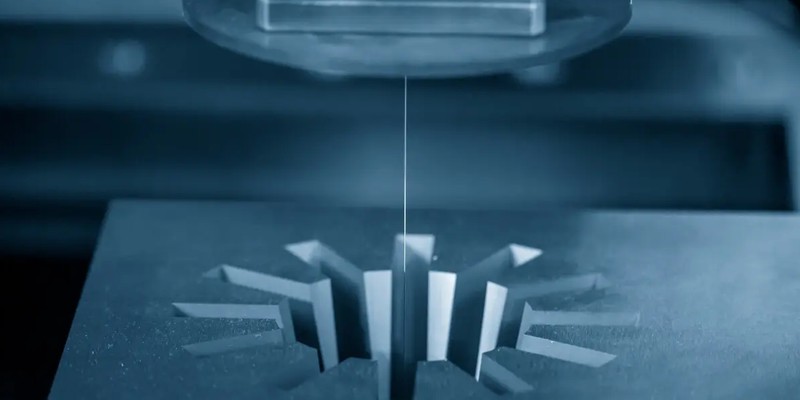- October 21, 2022
Wire EDM machining is an electrothermal production process that uses electric discharges to remove material from a workpiece. It is an improvement to the conventional EDM method, compatible with almost all conductive materials, and can create complex designs and shapes.
As a result, many parts manufacturers across several industries use it, as it is highly recommended in many CNC machine shops. This article will discuss wire EDM cutting, compatible materials, and its application in many industries.
What is Wire EDM?
Wire electrical discharge machining is a non-contact subtractive manufacturing process that uses an electrically charged thin wire with a dielectric fluid to cut a metal part into different shapes.
The process produces small chips and precise cut lines by melting or vaporizing the material rather than cutting it. As a result, it can conveniently machine parts unsuitable for conventional machining techniques. However, the parts must be electrically conductive.
How Does Wire EDM Work?
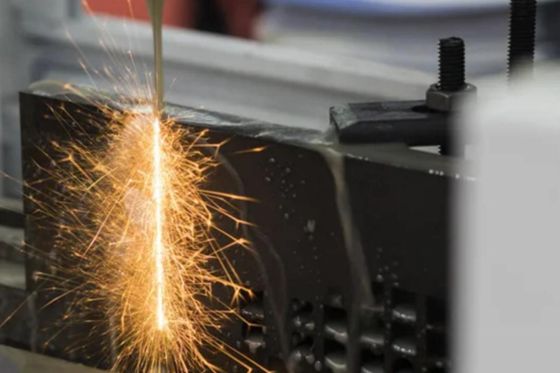
The wire-cut EDM process has a simple mechanism.
Machining a part using the process involves submerging the workpiece into a dielectric fluid, securing it with a machinist vise, and running the wire through it to produce sparks as it passes an electric current.
In other words, the wire carries one side of the charge, and the workpiece, which must be a conductive material, carries the other side of the charge. When the two get close, a hot electric charge jumps the gap and melts tiny pieces of the metal away.
The electric spark is the cutting tool to cut the material in the desired shape. Additionally, the wire EDM process involves deionized water to control the process and flush away tiny particles removed.
Components of A Wire EDM Machine
The machine comprises several parts that work together to give a material the desired shape. Below are the components of the machine.
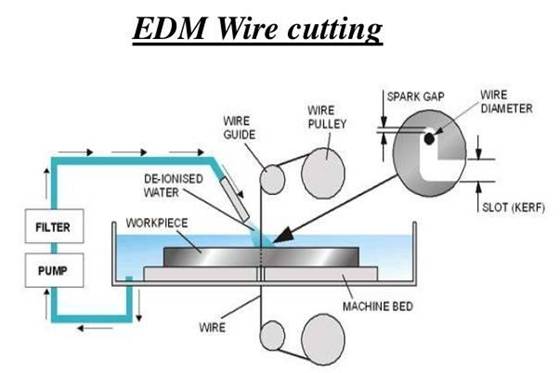
1. CNC Tools
The CNC tools control the entire operation of the Wire EDM machining process. Controlling the entire operations include being in control of the sequencing of the wire path and being able to manage the cutting process automatically.
Note: The CNC tool’s sophistication determines the error level and the machining time.
2. Power Supply
The power supply unit is the component that delivers pulses (from 100V to 300V) to the wire electrode and the workpiece. Furthermore, it controls the frequency and strength of the electrical charges that pass through the wire electrode to interact with the workpiece.
It is necessary to use a highly developed power supply unit to deliver the necessary quality and type of charges during Wire EDM machining.
3. Wire
The wire serves as the electrode to create the electrical discharge. The shape and thickness of the workpiece directly influence the wire’s diameter. Typically, one can use wires with diameters ranging from 0.05 to 0.25mm. The main types of wires used include
-Brass Wires
Brass is the most common EDM wire material because of its excellent conductive properties. It is an alloy of copper and zinc, and the higher the zinc content, the faster the wire cuts. However, there should be a balance because when the zinc content is over 40%, this decreases the corrosion rate of the brass wire.
-Zinc coated Wires
As the name implies, you obtain it by applying a coating of pure zinc or zinc oxide on the wire surface. Manufacturers use zinc-coated wires because it improves the machining speed.
-Diffusion-annealed Wires
The diffusion annealing process helps to create wires with higher zinc content (more than 40% zinc). It involves coating wires with layers of pure zinc. These wires are ideal for mass production and can machine many materials.
-How to Choose the Right Wire
- To choose the right EDM wire material for your project, consider the following
- Tensile Strength
- Fracture Resistance
- Conductivity
- Vaporization Temperature
- Hardness
4. Dielectric Medium
The wire-cut EDM process must be carried out in a tank filled with dielectric fluid. This liquid prevents the tiny particles from the workpiece from getting attached to the wire electrode. The most common medium is deionized water which cools the process and gives the workpiece a good surface finish.
5. Electrodes
The electrodes in the machine are the wire (cathode) and the workpiece (anode). The servo motor controls the wire electrode, ensuring it does not come in contact with the workpiece at any point during the wire EDM cutting process.
Materials A Wire EDM Machine Can Cut
Wire EDM machines can create complicated shapes and patterns on a workpiece. Additionally, they can machine most materials that can conduct electricity, even the tough and delicate.
Common shapes and materials you can cut with the machine include:
Aluminum
Aluminum has excellent thermal and electrical conductivity properties. However, aluminum is naturally soft and can be challenging to cut with the process as it may result in a gummy build-up after machining.
Titanium
Wire EDM cutting is perfect for titanium because the process can withstand the stickiness of this alloy and break up lengthy chips. However, you need deionized water as the dielectric medium to help control heat generation during machining.
Steel
Steel is a very strong metal. As a result, many manufacturers favor using a wire EDM machine over a CNC machine. However, the material generates a lot of heat, so one needs to take the necessary precautions.
Brass
Brass is easy to cut using the machine because it has high tensile strength. However, the cutting speed should be slow because it is a soft metal.
Graphite
It may be difficult to cut graphite using conventional cutting tools. But the wire EDM process is appropriate because the wire is sharp, preventing particle pull-out.
Differences Between EDM Wire Cutting and Conventional EDM
The wire-cut EDM process is an improvement on conventional EDM. Their mode of operation is similar. However, they have significant differences. Below is a few difference between both machining process.
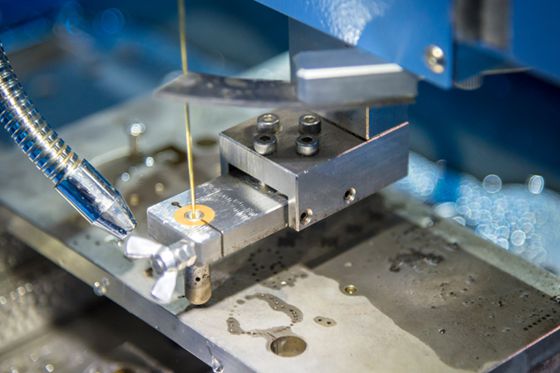
Electrode
As stated above, the electrode used in wire EDM cutting is a thin heated wire. In contrast, conventional EDM uses highly conductive metals like graphite or copper electrodes to produce electrical charges. The electrodes are in different shapes and sizes, which affects their smoothness. For example, a round electrode produces the smoothest surface. Then a square, triangle, and diamond. When the electrode is inserted into the workpiece, it forms a mold leaving a ‘negative’ impression of its shape.
Speed of Machining
The electrodes of conventional EDM must come in different shapes. As a result, manufacturers must create and shape them before the machining process, and this takes time. In contrast, the wire EDM machine is ready to use as soon as the wire is in position. This makes it appropriate for applications that must need to be completed quickly.
Accuracy
Wire EDM machining makes use of wire as the electrode. As a result, they have better accuracy than conventional EDM. For example, the wire electrode allows them to cut at a thickness of about 0.004inches. Due to their accuracy, they become better suited for machining parts with complex shapes and designs, unlike the conventional EDM, which is more suitable for more rigid cuts.
Applications
Wire EDM machining is versatile and can cut ferrous and non-ferrous metals, so many industries use it. Also, size and shape do not limit its use because it can machine both long parts and extremely small ones. However, conventional EDM can handle harder and thicker materials because the thickness of the wire electrode in a wire EDM machine affects its use.
Pros and Cons of Wire EDM Machining
Pros of Wire EDM
- It makes precise and accurate cuts eliminating the need for further processing and finishing of the workpiece.
- The process is suitable for creating complex designs and shapes that are otherwise challenging to produce using traditional CNC machining.
- It is applicable in machining small parts and for cutting highly detailed items that would otherwise be too delicate for other machining options.
- Wire EDM machining is ideal for fragile materials and cannot withstand the stress of machining.
- With just one stage of processing, the machine cuts materials leaving no burrs or distortion.
- The machining process cuts continuously without interruptions. Even if the wire breaks when cutting, the process continues immediately.
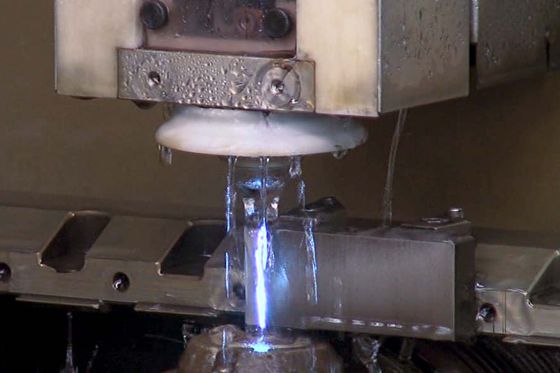
Cons of Wire EDM
- It is only compatible with materials that conduct electricity.
- An oxide layer may develop on the cut surface of some materials, such as aluminum. Therefore, this could necessitate additional finishing, which raises the cost.
- It has a high initial investment and maintenance cost.
Applications of Wire Electrical Discharge Machining
Many industries use wire EDM machines from prototyping to complete production runs. Below are some industries.
Automotive Industry
The parts in the automotive industry come in complex shapes and sizes and are mostly hard. As a result, the industry favors using wire EDM machines because the process does not rely on mechanical forces, and the wire electrode does not need to be stronger than the workpiece. The process applies to making holes and cavities to customize automotive car parts like bumpers, dashboards, car doors, and many more.
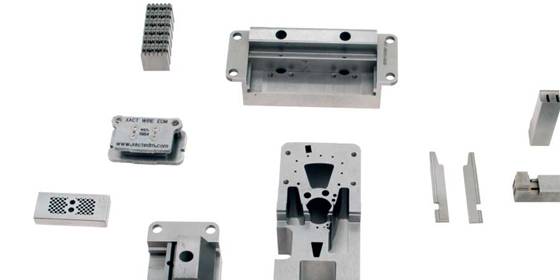
Medical Industry
Wire EDM machines produce complex parts with a high level of accuracy for use in all medical fields, including optometry and dentistry. Also, metals that work well with wire EDM services are frequently used to manufacture medical equipment.
Since the wire’s diameter determines the cut’s size, the wire EDM machine adds tiny features to parts like dental implants and syringe components without endangering their structural integrity.
Aerospace Industry
Wire EDM cutting produces parts with tight tolerances and is the go-to machining process for aerospace part manufacturers. This process, alongside the waterjet cutting process, is especially used for parts that cannot withstand the high temperature and stress associated with traditional cutting tools.
Parts in the aerospace industry need to have an excellent surface finish and be precise and accurate. Manufacturers use the wire EDM process for years to make engines, turbine blades, landing gear parts, and many more.
Conclusion
Wire EDM is a versatile and precise machining process that can be used to create complex shapes and geometries. It is often used in the aerospace and medical industries, where parts need to meet tight tolerances. Wire EDM can also be used to create prototypes or one-off parts. In this article, we hope that you now have a better understanding of wire EDM.
Looking for a professional manufacturer to implement your wire EDM cutting project?WayKen is a manufacturing services company with a deep knowledge of all CNC processes, including wire EDM. Our process enables us to create high-precision cuts for any conductive material. So, regardless of your part requirements and applications, Our EDM manufacturing experts will help you get your products made
Simply upload your CAD file today to receive an instant quote. We’re happy to work with you to find the right solution.
FAQ
What are the other types of EDM available?
Other than wire EDM, there is the hole drilling EDM and sinker EDM. The difference is in the electrode used. The electrodes in hole EDM are tubular and create tinier and deeper holes. On the other hand, sinker EDM uses an electrically conductive metal to form a ‘positive’ of the desired shape.
What’s the difference between wire EDM and laser cutting?
Laser cutting uses a high-powered thermal beam to cut materials, while a wire EDM uses electrical erosion from a wire.
Why is deionized water used in wire cut EDM?
Because of its low carbon property, deionized water is the dielectric medium used in wire EDM. It serves as a coolant to regulate the dielectric temperature.

